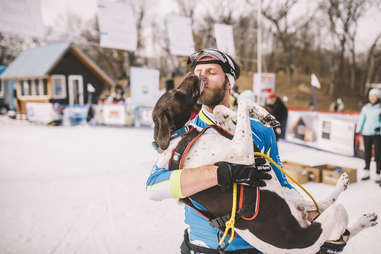Skijoring Is Basically Dog Sledding, Minus the Sled
It's the winter sport of champions (and their best friends).

You might be familiar with less-beloved winter sports, having tuned into enough Winter Olympics to retain a few sound bites about curling or skeleton racing. Maybe you're even an aficionado of the obscure art of ski ballet. But that doesn’t mean you’re familiar with skijoring, which begs the question: Do you really love your dog?
Skijoring comes from the Norwegian skikjøring, or “ski driving.” Basically, you’re standing on cross-country skis, holding a rope, the other end of which is attached to a dog, a couple of dogs, or a horse if you're particularly hardcore. According to Nancy Knutson, director of marketing and communications for the American Birkebeiner Ski Foundation, skijoring has been around for centuries, going back to a time when animals and skis were both commonly used for basic transportation.
In less traditional interpretations, you can even use a car. (So basically, that time I careened around on a sled towed by my best friend’s car was not just stupid, but ahead of its time.)
Is skijoring a thing in the US?
Competitive skijoring is very much a thing, and has been happening in the US for at least the past century. It’s never quite broken into the mainstream, but you can watch skijoring races at family-friendly festivals like Minnesota's Great Northern, which is still on for 2021 as of press time. In recent years, winter-getaway travel destinations have also added skijoring to their offerings. Horse-skijoring can involve either a second person riding the horse, or in some cases the skijorer going it alone. Whitefish, Montana, hosts the annual World Championship each January, though unseasonable weather derailed it last year.
Every February in Hayward, Wisconsin, you can find skijorers and their Very Good Dogs racing down Main Street in the annual Barkie Birkie Skijor. For newbies, know that dog-skijoring is a bit more feasible because folks are more likely to have the requisite equipment. Which leads to the next question:

Wait, I can skijor with my own dog?
We now turn to the question everyone is itching to ask—the answer is yes, as any dog owner who has encountered a squirrel while cross-country skiing can attest.
Those of you wishing to BYOD will need a pup weighing at least 30lbs (preferably 35) that is at least one year old and generally healthy. You yourself should be at least somewhat comfortable on cross-country skis. You can check out a breakdown of the standard equipment here.
“If heading out on your own, look for dog-friendly parks with multi-use trails or trails that have not already been groomed specifically for cross-country skiers,” Knutson advises.
And for everyone else who wants to take the guesswork and/or animal ownership out of the equation, you can try one of these.
Triple Creek Ranch, Montana
Equestrian skijoring, like equestrian everything, is a bit more prevalent in Montana than it is most other places in the country. No matter their skill level, guests at Triple Creek—near Montana’s western border—can try skijoring behind a horse as one of the ranch’s all-inclusive activities.
The Resort at Paws Up, Montana
This 37,000-acre resort surrounded by dense national forest land recently introduced skijoring to its guests, boasting a trail specifically designed for competitive training, resembling an obstacle course of sorts. Guests ages 12 and up can try an hour and a half of equestrian skijoring for $200.
Devil’s Thumb Ranch, Colorado
For those of you wanting to try skijoring with a dog (yours) rather than a horse (any), this ranch will rent you doggy-skijoring equipment for $20, plus regular clinics you can take to improve your skills. Enjoy the many miles of trails nestled around the base of Colorado’s Continental Divide.
Loppet Foundation, Minnesota
If you can provide your own skis and dog, expert skijorer Torrey Swanson will lead you in an introductory session (free; don’t need the dog yet) followed by a session out on the snow ($40; you may fetch your dog now).
